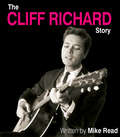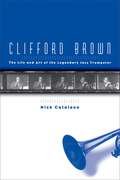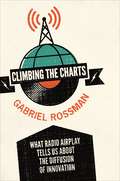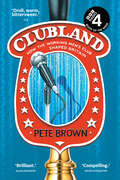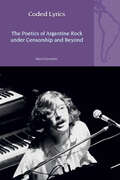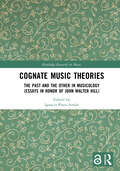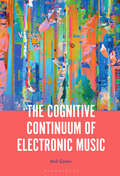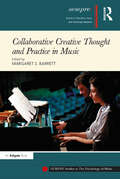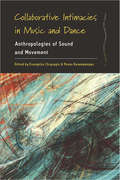- Table View
- List View
Cliff Richard Story
by Mike ReadCliff Richard has been a muscial icon for 5 decades, and this eBook has been released to help celebrate his 70th birthday last October. 250 million record sales later - Cliff still continues to delight his fans with new music and spectacular live performances. The book is written by ex DJ and Cliff's goof friend Mike Read.
Clifford Brown: The Life and Art of the Legendary Jazz Trumpeter
by Nick CatalanoAlthough he died in a tragic car accident at twenty-five, Clifford Brown is widely considered one of the most important figures in the history of jazz, a trumpet player who ranks with Louis Armstrong, Dizzy Gillespie, and Miles Davis, and a leading influence on contemporary jazz musicians. Now, in Clifford Brown: The Life and Art of the Legendary Jazz Trumpeter, Nick Catalano gives us the first major biography of this musical giant. Based on extensive interviews with Clifford Brown's family, friends, and fellow jazz musicians, here is a fascinating portrait of a remarkable musician. Catalano depicts Brown's early life, showing how he developed a facility and dazzling technique that few jazz players have ever equaled. We read of his meteoric rise in Philadelphia, where he played with many of the leading jazz players of the 1950s, including Dizzy Gillespie and Charlie Parker; his tour of Europe with Lionel Hampton, which made him famous; and his formation of the Brown-Roach Quintet with prominent drummer Max Roach--one of the most popular hard bop combos of the day. Catalano also shows that Brown was a remarkable individual--he grew up in a middle-class African-American home in Wilmington, Delaware, attended college, was a skilled mathematician, and had wide cultural interests. Moreover, in an era when most jazz players were either alcoholics or addicts, Brown was clean-living and drug free. Indeed, he became a role model for musicians who were struggling with drugs and had great influence in this area with one prominent colleague, tenor sax player Sonny Rollins. Clifford Brown not only provides a colorful account of Brown's life, but also features an informed analysis of his major recorded solos, highlighting Brown's originality and revealing why he remains a great influence on trumpet players today. It is a book that anyone with a serious interest in jazz will want to own.
Climbing the Charts: What Radio Airplay Tells Us about the Diffusion of Innovation
by Gabriel RossmanDespite the growth of digital media, traditional FM radio airplay still remains the essential way for musicians to achieve commercial success. Climbing the Charts examines how songs rise, or fail to rise, up the radio airplay charts. Looking at the relationships between record labels, tastemakers, and the public, Gabriel Rossman develops a clear picture of the roles of key players and the gatekeeping mechanisms in the commercial music industry. Along the way, he explores its massive inequalities, debunks many popular misconceptions about radio stations' abilities to dictate hits, and shows how a song diffuses throughout the nation to become a massive success. Contrary to the common belief that Clear Channel sees every sparrow that falls, Rossman demonstrates that corporate radio chains neither micromanage the routine decision of when to start playing a new single nor make top-down decisions to blacklist such politically inconvenient artists as the Dixie Chicks. Neither do stations imitate either ordinary peers or the so-called kingmaker radio stations who are wrongly believed to be able to make or break a single. Instead, Rossman shows that hits spread rapidly across radio because they clearly conform to an identifiable style or genre. Radio stations respond to these songs, and major labels put their money behind them through extensive marketing and promotion efforts, including the illegal yet time-honored practice of payoffs known within the industry as payola. Climbing the Charts provides a fresh take on the music industry and a model for understanding the diffusion of innovation.
Climbing the Charts: What Radio Airplay Tells Us about the Diffusion of Innovation (PDF)
by Gabriel RossmanDespite the growth of digital media, traditional FM radio airplay still remains the essential way for musicians to achieve commercial success. Climbing the Charts examines how songs rise, or fail to rise, up the radio airplay charts. Looking at the relationships between record labels, tastemakers, and the public, Gabriel Rossman develops a clear picture of the roles of key players and the gatekeeping mechanisms in the commercial music industry. Along the way, he explores its massive inequalities, debunks many popular misconceptions about radio stations' abilities to dictate hits, and shows how a song diffuses throughout the nation to become a massive success. Contrary to the common belief that Clear Channel sees every sparrow that falls, Rossman demonstrates that corporate radio chains neither micromanage the routine decision of when to start playing a new single nor make top-down decisions to blacklist such politically inconvenient artists as the Dixie Chicks. Neither do stations imitate either ordinary peers or the so-called kingmaker radio stations who are wrongly believed to be able to make or break a single. Instead, Rossman shows that hits spread rapidly across radio because they clearly conform to an identifiable style or genre. Radio stations respond to these songs, and major labels put their money behind them through extensive marketing and promotion efforts, including the illegal yet time-honored practice of payoffs known within the industry as payola. Climbing the Charts provides a fresh take on the music industry and a model for understanding the diffusion of innovation.
Closer than Ever: The Unique Six-Decade Songwriting Partnership of Richard Maltby Jr. and David Shire (Broadway Legacies)
by Joshua RosenblumHow do musical theater songs actually get written? What enables some composer and lyricist partnerships to last for decades? Composer David Shire and lyricist Richard Maltby, Jr., two of the most gifted songwriters of our time, are revered among musical theater lovers for their ground-breaking off-Broadway revues Starting Here, Starting Now and Closer Than Ever, as well as for the Broadway musicals Baby and Big. Rosenblum sets out to increase appreciation for Maltby and Shire's large and impressive body of work and establish their place in musical theater history. This book chronicles their sixty-six-year (and counting) partnership, giving full behind-the-scenes accounts of their musicals, interspersed with deep-dive analyses of standout individual numbers. Other well-known artistic figures who feature prominently in the Maltby/Shire story include Stephen Sondheim, Hal Prince, Michael Stewart, Francis Ford Coppola, Craig Lucas, Mike Ockrent, Susan Stroman, John Weidman, Charles Strouse, Garth Drabinsky, Adam Gopnik, Jason Robert Brown, and Jonathan Tunick. Using his experiences as a Broadway conductor, music journalist, and professor of musical theater composition, as well as his long-term personal and professional acquaintance with both Maltby and Shire, Joshua Rosenblum is uniquely suited to chronicle their lives, careers, and creative output. The songwriters, both of whom are engaging and articulate in describing what they do, are quoted liberally throughout the book in exclusive interviews, creating the impression that one is spending time with two inspiring creative artists who happen to be great company.
Closer than Ever: The Unique Six-Decade Songwriting Partnership of Richard Maltby Jr. and David Shire (Broadway Legacies)
by Joshua RosenblumHow do musical theater songs actually get written? What enables some composer and lyricist partnerships to last for decades? Composer David Shire and lyricist Richard Maltby, Jr., two of the most gifted songwriters of our time, are revered among musical theater lovers for their ground-breaking off-Broadway revues Starting Here, Starting Now and Closer Than Ever, as well as for the Broadway musicals Baby and Big. Rosenblum sets out to increase appreciation for Maltby and Shire's large and impressive body of work and establish their place in musical theater history. This book chronicles their sixty-six-year (and counting) partnership, giving full behind-the-scenes accounts of their musicals, interspersed with deep-dive analyses of standout individual numbers. Other well-known artistic figures who feature prominently in the Maltby/Shire story include Stephen Sondheim, Hal Prince, Michael Stewart, Francis Ford Coppola, Craig Lucas, Mike Ockrent, Susan Stroman, John Weidman, Charles Strouse, Garth Drabinsky, Adam Gopnik, Jason Robert Brown, and Jonathan Tunick. Using his experiences as a Broadway conductor, music journalist, and professor of musical theater composition, as well as his long-term personal and professional acquaintance with both Maltby and Shire, Joshua Rosenblum is uniquely suited to chronicle their lives, careers, and creative output. The songwriters, both of whom are engaging and articulate in describing what they do, are quoted liberally throughout the book in exclusive interviews, creating the impression that one is spending time with two inspiring creative artists who happen to be great company.
Closer You Are: The Story of Robert Pollard and Guided By Voices
by Matthew CutterThe authorized biography of Robert Pollard, indie rock icon and founder of the music group Guided By Voices Robert Pollard has been a staple of the indie rock scene since the early '80s, along with his band Guided By Voices. Pollard was a longtime grade school teacher who toiled endlessly on his music, finding success only after adopting a do-it-yourself approach, relying on lo-fi home recordings for much of his and his band's career. A prolific artist, Pollard continues to churn out album after album, much to the acclaim of critics and his obsessive and devoted fans. But his story has never been faithfully told in its entirety. Until now. Author Matthew Cutter is a longtime friend of Pollard and, with Pollard's blessing, he's set out to tell the whole, true story of Guided By Voices. Closer You Are is the first book to take an in-depth look at the man behind it all, with interviews conducted by the author with Pollard's friends, family, and bandmates, along with unfettered access to Pollard himself and his extensive archives. Robert Pollard has had an amazing and seemingly endless career in rock music, but he's also established himself as a consummate artist who works on his own terms. Now fans can at long last learn the full story behind one of America's greatest living songwriters.
Clothes, Clothes, Clothes. Music, Music, Music. Boys, Boys, Boys. (Faber Social Ser.)
by Viv AlbertineViv Albertine is one of a handful of original punks who changed music, and the discourse around it, forever. In Clothes ... Music ... Boys a story hitherto dominated by male voices is recast through the eyes of one of the most glamorous, uncompromising and iconic figures of the time. After forming The Flowers of Romance with Sid Vicious in 1976, Viv joined The Slits and made musical history as one of the first generation of punk bands. Here is the story of what it was like to be a girl at the height of punk: the sex, the drugs, the guys, the tours, the hard lessons learnt and those not considered. From Madonna to Lady Gaga, fashion to feminims, Viv Albertine has influenced a range of exceptional artists. Here, before and beyond the break-up of The Slits in 1982, is the full story of a life lived unscripted, with foolishness, bravery and great emotional honesty. A memoir full of raw and uncompromising anecdote and opinion, Clothes, Clothes, Clothes. Music, Music, Music. Boys, Boys, Boys is an unflinching account of a life lived on the frontiers of experience, by a true pioneer.
Clubland: How The Working Men's Club Shaped Britain
by Pete Brown‘Brilliant.’ Alan Johnson ‘Compelling.’ David Kynaston ‘The beer drinkers’ Bill Bryson.’ Times Literary Supplement
Coal Black Mornings
by Brett AndersonEvening Standard Book of the Year. Observer Book of the Year. Guardian Book of the Year. Sunday Times Book of the Year. Telegraph Book of the Year. New Statesman Book of the Year. Herald Book of the Year. Mojo Book of the Year.Brett Anderson came from a world impossibly distant from rock star success, and in Coal Black Mornings he traces the journey that took him from a childhood as 'a snotty, sniffy, slightly maudlin sort of boy raised on Salad Cream and milky tea and cheap meat' to becoming founder and lead singer of Suede.Anderson grew up in Hayward's Heath on the grubby fringes of the Home Counties. As a teenager he clashed with his eccentric taxi-driving father (who would parade around their council house dressed as Lawrence of Arabia, air-conducting his favourite composers) and adored his beautiful, artistic mother. He brilliantly evokes the seventies, the suffocating discomfort of a very English kind of poverty and the burning need for escape that it breeds. Anderson charts the shabby romance of creativity as he travelled the tube in search of inspiration, fuelled by Marmite and nicotine, and Suede's rise from rehearsals in bedrooms, squats and pubs. And he catalogues the intense relationships that make and break bands as well as the devastating loss of his mother.Coal Black Mornings is profoundly moving, funny and intense - a book which stands alongside the most emotionally truthful of personal stories.
Coded Lyrics: The Poetics of Argentine Rock under Censorship and Beyond (Liverpool Latin American Studies #31)
by Mara FavorettoCoded Lyrics is the first comprehensive academic work dedicated to unraveling the lyrical intricacies of Argentine rock in the English language. This book redefines the narrative of rock history, shedding light on the distinctive journey undertaken by South American rock music amidst a unique set of contextual challenges, far removed from its English-speaking counterparts. Within this vibrant musical landscape, Argentine rock emerges as a shining example of cultural resistance in the region. Focusing intently on Argentina's tumultuous authoritarian decades and the post-dictatorship era, this book delves deep into the heart of the Argentine rock genre's lyrical content. It vividly portrays the ongoing struggle between the state and the public, where identity, language, and perception converge around the powerful medium of rock music. Coded Lyrics is not a conventional musicological study; instead, it serves as a meticulous exploration of language and culture. With captivating prose, the book unravels the genesis of Argentine rock, placing language at its epicentre. Through a thorough examination of rock lyrics, this work unveils the artful manipulation of language as a vehicle for resistance. It illuminates the unexpected consequences of censorship in Argentina, with Argentine rock lyrics standing as a compelling testament to the transformative power of art in the face of totalitarianism.
Coded Lyrics: The Poetics of Argentine Rock under Censorship and Beyond (Liverpool Latin American Studies #31)
by Mara FavorettoCoded Lyrics is the first comprehensive academic work dedicated to unraveling the lyrical intricacies of Argentine rock in the English language. This book redefines the narrative of rock history, shedding light on the distinctive journey undertaken by South American rock music amidst a unique set of contextual challenges, far removed from its English-speaking counterparts. Within this vibrant musical landscape, Argentine rock emerges as a shining example of cultural resistance in the region. Focusing intently on Argentina's tumultuous authoritarian decades and the post-dictatorship era, this book delves deep into the heart of the Argentine rock genre's lyrical content. It vividly portrays the ongoing struggle between the state and the public, where identity, language, and perception converge around the powerful medium of rock music. Coded Lyrics is not a conventional musicological study; instead, it serves as a meticulous exploration of language and culture. With captivating prose, the book unravels the genesis of Argentine rock, placing language at its epicentre. Through a thorough examination of rock lyrics, this work unveils the artful manipulation of language as a vehicle for resistance. It illuminates the unexpected consequences of censorship in Argentina, with Argentine rock lyrics standing as a compelling testament to the transformative power of art in the face of totalitarianism.
Cognate Music Theories: The Past and the Other in Musicology (Essays in Honor of John Walter Hill) (Routledge Research in Music)
by Ignacio Prats-ArolasThis volume explores the possibilities of cognate music theory, a concept introduced by musicologist John Walter Hill to describe culturally and historically situated music theory.Cognate music theories offer a new way of thinking about music theory, music history, and the relationship between insider and outsider perspectives when researchers mediate between their own historical and cultural position, and that of the originators of the music they are studying. With contributions from noted scholars of musicology, music theory, and ethnomusicology, this volume develops a variety of approaches using the cognate music theory framework and shows how this concept enables more nuanced and critical analyses of music in historical context.Addressing topics in music from the seventeenth to nineteenth centuries, this volume will be relevant to musicologists, music theorists, and all researchers interested in reflecting critically on what it means to construct a theory of music.
Cognate Music Theories: The Past and the Other in Musicology (Essays in Honor of John Walter Hill) (Routledge Research in Music)
This volume explores the possibilities of cognate music theory, a concept introduced by musicologist John Walter Hill to describe culturally and historically situated music theory.Cognate music theories offer a new way of thinking about music theory, music history, and the relationship between insider and outsider perspectives when researchers mediate between their own historical and cultural position, and that of the originators of the music they are studying. With contributions from noted scholars of musicology, music theory, and ethnomusicology, this volume develops a variety of approaches using the cognate music theory framework and shows how this concept enables more nuanced and critical analyses of music in historical context.Addressing topics in music from the seventeenth to nineteenth centuries, this volume will be relevant to musicologists, music theorists, and all researchers interested in reflecting critically on what it means to construct a theory of music.
The Cognitive Continuum of Electronic Music
by Anil ÇamciThe electronic medium allows any audible sound to be contextualized as music. This brings about unique structural possibilities as spectrum, dynamics, space, and time become continuous dimensions of musical articulation. What we hear in electronic music ventures beyond what we traditionally characterize as musical sound and challenge our auditory perception on the one hand and our imagination on the other. Based on an extensive listening study conducted over four years, this book offers a comprehensive analysis of the cognitive processes involved in the experience of electronic music. It pairs artistic practice with theories from a range of disciplines to communicate how this music operates on perceptual, conceptual, and affective levels. Looking at the common and the divergent ways in which our minds respond to electronic sound, the book investigates how we build narratives from of our experience of electronic music and how we situate ourselves in them.
The Cognitive Continuum of Electronic Music
by Anil ÇamciThe electronic medium allows any audible sound to be contextualized as music. This brings about unique structural possibilities as spectrum, dynamics, space, and time become continuous dimensions of musical articulation. What we hear in electronic music ventures beyond what we traditionally characterize as musical sound and challenge our auditory perception on the one hand and our imagination on the other. Based on an extensive listening study conducted over four years, this book offers a comprehensive analysis of the cognitive processes involved in the experience of electronic music. It pairs artistic practice with theories from a range of disciplines to communicate how this music operates on perceptual, conceptual, and affective levels. Looking at the common and the divergent ways in which our minds respond to electronic sound, the book investigates how we build narratives from of our experience of electronic music and how we situate ourselves in them.
Cognitive Foundations of Musical Pitch (Oxford Psychology Series #17)
by Carol L. KrumhanslThis book addresses the central problem of music cognition: how listeners' responses move beyond mere registration of auditory events to include the organization, interpretation, and remembrance of these events in terms of their function in a musical context of pitch and rhythm. Equally important, the work offers an analysis of the relationship between the psychological organization of music and its internal structure. Combining over a decade of original research on music cognition with an overview of the available literature, the work will be of interest to cognitive and physiological psychologists, psychobiologists, musicians, music researchers, and music educators. The author provides the necessary background in experimental methodology and music theory so that no specialized knowledge is required for following her major arguments.
Coherence in New Music: Experience Aesthetics Analysis
by Mark HutchinsonWhat does it mean to talk about musical coherence at the end of a century characterised by fragmentation and discontinuity? How can the diverse influences which stand behind the works of many late twentieth-century composers be reconciled with the singular immediacy of the experiences that they can create? How might an awareness of the distinctive ways in which these experiences are generated and controlled affect the way we listen to, reflect upon and write about this music? Mark Hutchinson outlines a novel concept of coherence within Western art music from the 1980s to the turn of the millennium as a means of understanding the work of a number of contemporary composers, including Thomas Adès, Kaija Saariaho, Tō ru Takemitsu and György Kurtág, whose music cannot be fitted easily into a particular compositional school or analytical framework. Coherence is understood as a multi-layered phenomenon experienced, above all, in the act of listening, but reliant upon a variety of other aspects of musical experience, including compositional statements, analysis, and connections of aesthetic, as well as listeners' own, imaginative conceptualisations. Accordingly, the approach taken here is similarly multi-faceted: close analytical readings of a number of specific works are combined with insights drawn from philosophy and aesthetics, music perception, and critical theory, with a particular openness to novel metaphorical presentations of basic musical ideas about form, language and time.
Coherence in New Music: Experience, Aesthetics, Analysis
by Mark HutchinsonWhat does it mean to talk about musical coherence at the end of a century characterised by fragmentation and discontinuity? How can the diverse influences which stand behind the works of many late twentieth-century composers be reconciled with the singular immediacy of the experiences that they can create? How might an awareness of the distinctive ways in which these experiences are generated and controlled affect the way we listen to, reflect upon and write about this music? Mark Hutchinson outlines a novel concept of coherence within Western art music from the 1980s to the turn of the millennium as a means of understanding the work of a number of contemporary composers, including Thomas Adès, Kaija Saariaho, Tō ru Takemitsu and György Kurtág, whose music cannot be fitted easily into a particular compositional school or analytical framework. Coherence is understood as a multi-layered phenomenon experienced, above all, in the act of listening, but reliant upon a variety of other aspects of musical experience, including compositional statements, analysis, and connections of aesthetic, as well as listeners' own, imaginative conceptualisations. Accordingly, the approach taken here is similarly multi-faceted: close analytical readings of a number of specific works are combined with insights drawn from philosophy and aesthetics, music perception, and critical theory, with a particular openness to novel metaphorical presentations of basic musical ideas about form, language and time.
Colin Thackery – My Story: How Love Changed Everything – from the Winner of Britain's Got Talent
by Colin ThackeryA tale of survival, love, hardship, family, heartbreak and triumph.This is the incredible story of 89-year-old Chelsea Pensioner Sergeant Major Colin Thackery who, in 2019, made history by becoming the oldest person to win Britain's Got Talent. The show gave a glimpse into Colin's history, but the truth of his unique and eventful life is far more gripping and surprising than viewers could have imagined. Enthralling, poignant and inspiring, this book tells Colin's story, from being a child helping Air Raid Wardens during The Blitz, through fighting in the Korean War, touring the world with the army, becoming a widower after 66 years of marriage, life as a Chelsea Pensioner and touching the nation's hearts with his show-winning singing in honour of his late wife, Joan.Ultimately, Colin's story is a tale of triumph: of resilience in the hardest of times; of hope in the face of despair; and of everlasting love.
Collaborative Creative Thought and Practice in Music (SEMPRE Studies in The Psychology of Music)
by Margaret S. BarrettThe notion of the individual creator, a product in part of the Western romantic ideal, is now troubled by accounts and explanations of creativity as a social construct. While in collectivist cultures the assimilation (but not the denial) of individual authorship into the complexities of group production and benefit has been a feature, the notion of the lone individual creator has been persistent. Systems theories acknowledge the role of others, yet at heart these are still individual views of creativity - focusing on the creative individual drawing upon the work of others rather than recognizing the mutually constitutive elements of social interactions across time and space. Focusing on the domain of music, the approach taken in this book falls into three sections: investigations of the people, processes, products, and places of collaborative creativity in compositional thought and practice; explorations of the ways in which creative collaboration provides a means of crossing boundaries between disciplines such as music performance and musicology; and studies of the emergence of creative thought and practice in educational contexts including that of the composer and the classroom. The volume concludes with an extended chapter that reflects on the ways in which the studies reported advance understandings of creative thought and practice. The book provides new perspectives to our understandings of the role of collaborative thought and processes in creative work across the domain of music including: composition, musicology, performance, music education and music psychology.
Collaborative Creative Thought and Practice in Music (SEMPRE Studies in The Psychology of Music)
by Margaret S. BarrettThe notion of the individual creator, a product in part of the Western romantic ideal, is now troubled by accounts and explanations of creativity as a social construct. While in collectivist cultures the assimilation (but not the denial) of individual authorship into the complexities of group production and benefit has been a feature, the notion of the lone individual creator has been persistent. Systems theories acknowledge the role of others, yet at heart these are still individual views of creativity - focusing on the creative individual drawing upon the work of others rather than recognizing the mutually constitutive elements of social interactions across time and space. Focusing on the domain of music, the approach taken in this book falls into three sections: investigations of the people, processes, products, and places of collaborative creativity in compositional thought and practice; explorations of the ways in which creative collaboration provides a means of crossing boundaries between disciplines such as music performance and musicology; and studies of the emergence of creative thought and practice in educational contexts including that of the composer and the classroom. The volume concludes with an extended chapter that reflects on the ways in which the studies reported advance understandings of creative thought and practice. The book provides new perspectives to our understandings of the role of collaborative thought and processes in creative work across the domain of music including: composition, musicology, performance, music education and music psychology.
Collaborative Intimacies in Music and Dance: Anthropologies of Sound and Movement (Dance and Performance Studies #10)
by Evangelos Chrysagis and Panas KarampampasAcross spatial, bodily, and ethical domains, music and dance both emerge from and give rise to intimate collaboration. This theoretically rich collection takes an ethnographic approach to understanding the collective dimension of sound and movement in everyday life, drawing on genres and practices in contexts as diverse as Japanese shakuhachi playing, Peruvian huayno, and the Greek goth scene. Highlighting the sheer physicality of the ethnographic encounter, as well as the forms of sociality that gradually emerge between self and other, each contribution demonstrates how dance and music open up pathways and give shape to life trajectories that are neither predetermined nor teleological, but generative.
Collaborative Learning in Higher Music Education (SEMPRE Studies in The Psychology of Music)
by Helena Gaunt Heidi WesterlundIn higher music education, learning in social settings (orchestras, choirs, bands, chamber music and so on) is prevalent, yet understanding of such learning rests heavily on the transmission of knowledge and skill from master to apprentice. This narrow view of learning trajectories pervades in both one-to-one and one-to-many contexts. This is surprising given the growing body of knowledge about the power of collaborative learning in general, underpinned by theoretical developments in educational psychology: the social dimensions of learning, situational learning and concepts of communities of learners. Collaborative Learning in Higher Music Education seeks to respond to the challenge of becoming more conscious of the creative and multiple dimensions of social interaction in learning music, in contexts ranging from interdisciplinary projects to one-to-one tuition, and not least in the contemporary context of rapid change in the cultural industries and higher education as a whole. It brings together theoretical papers and case studies of practice. Themes covered include collaborative creativity, communities of practice, peer-learning, co-teaching as co-learning, assessment and curriculum structures. Chapters illuminate reasons for enabling collaborative learning, and provide exemplars of innovative practice and designs for collaborative learning environments in higher music education. A central purpose of the book is to scaffold change, to help in meeting the rapid changes in society and to find constructive stepping stones or signposts for teachers and students.
Collaborative Learning in Higher Music Education (SEMPRE Studies in The Psychology of Music)
by Helena Gaunt Heidi WesterlundIn higher music education, learning in social settings (orchestras, choirs, bands, chamber music and so on) is prevalent, yet understanding of such learning rests heavily on the transmission of knowledge and skill from master to apprentice. This narrow view of learning trajectories pervades in both one-to-one and one-to-many contexts. This is surprising given the growing body of knowledge about the power of collaborative learning in general, underpinned by theoretical developments in educational psychology: the social dimensions of learning, situational learning and concepts of communities of learners. Collaborative Learning in Higher Music Education seeks to respond to the challenge of becoming more conscious of the creative and multiple dimensions of social interaction in learning music, in contexts ranging from interdisciplinary projects to one-to-one tuition, and not least in the contemporary context of rapid change in the cultural industries and higher education as a whole. It brings together theoretical papers and case studies of practice. Themes covered include collaborative creativity, communities of practice, peer-learning, co-teaching as co-learning, assessment and curriculum structures. Chapters illuminate reasons for enabling collaborative learning, and provide exemplars of innovative practice and designs for collaborative learning environments in higher music education. A central purpose of the book is to scaffold change, to help in meeting the rapid changes in society and to find constructive stepping stones or signposts for teachers and students.
